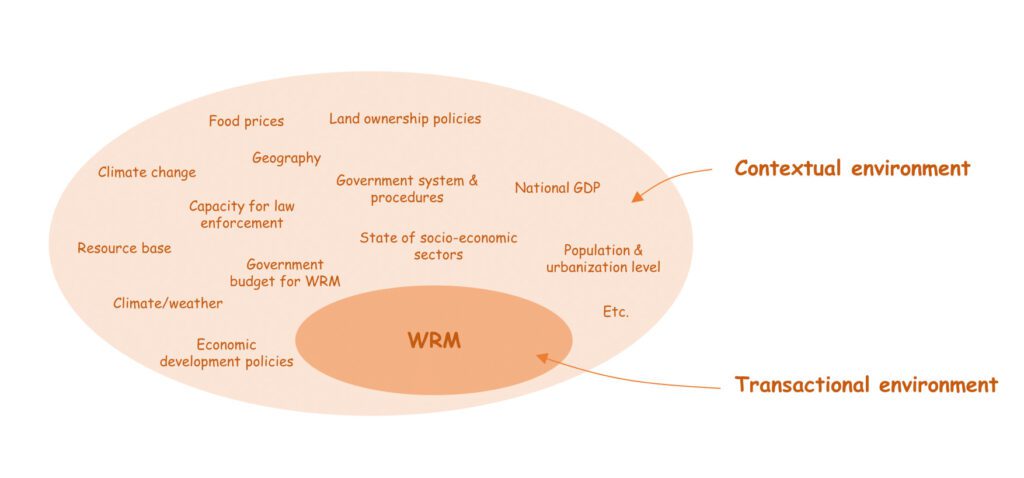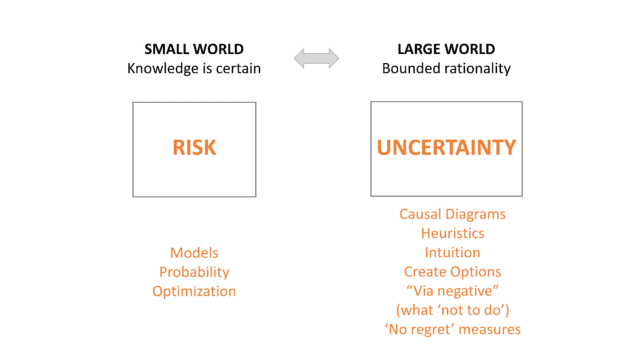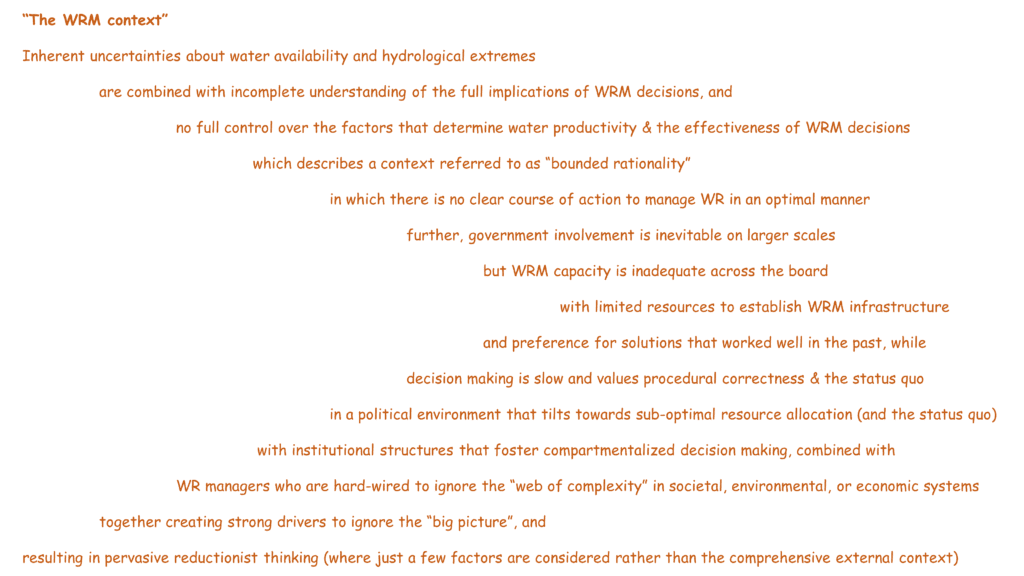This post will start with two observations from a recent blog post on contemporary paradoxes in the water resources management:
- Seeing the “bigger picture” is key to addressing water resources issues at basin scale and beyond.
- Failure to do so—thus, in effect adopting a reductionist approach—is the root cause of many intractable problems in water resources management.
With the above in mind, this post aims to describe the contextual environment in which water resources are managed. Since we are interested in the overarching context—the ‘bigger picture’—this description is broad and will cover epistemological, institutional, and even cognitive factors.

The contextual environment is that part of the environment which has important repercussions on WRM but in which water managers have little to no control (adapted from van der Heijden, 2005). External scenarios about climate change or socio-economic development play in the contextual environment. Water managers also have little influence over government structures and the central budget allocation process.
The transactional environment is that part of the environment in which WR managers are a significant player, influencing outcomes as much as being influenced by them. This is where WRM methodologies and procedures are being employed.
WRM mostly takes place in the transactional environment. Understanding the key features of the contextual environment, however, provides perspective and is useful to understand the limitations of WRM.
Bounded rationality: epistemological limitations
Hydrology is an inexact science.
The parameters that affect what happens to a raindrop are subject to (very) high spatial variability. These parameters include soil type, geology, vegetation, land use, relief, rainfall regime and many others. They can change from one plot to another, or even within a plot. Some change from season to season, while others are changed because of human interactions with the landscape like agriculture, deforestation, urbanization, etc.
A similar line of reasoning can be developed for the other key hydrological parameter: evapotranspiration, although in this case future advancements in remote sensing could provide more clarity. By contrast, climate change—and its non-linear impacts—is adding a new dimension to the uncertainties involved.
Thus, in practice, it is impossible to accurately understand and represent the hydrological processes. In fact, we barely know what is going on in a particular watershed.
While a statistical analysis of the hydrological parameters can be useful at a larger scale—provided we have accurate data (a big ‘if’ in many places)—this is not the case for smaller scales and specifically not for hydrological extremes.
I think this concerns an epistemological problem, and my sense is that this will not change with the emergence of AI tools based on more accurate remote-sensed data. Hence there are inherent uncertainties about the availability and distribution of water resources. The best we can do is an approximation.
Understanding the full spectrum of interlinkages between water and the socio-economic-environmental sectors is impossible.
Water is related to many aspects of the environment and the performance of key socio-economic sectors. These interlinkages are complex and go in both directions. They are difficult to map, let alone to quantify.
Take for instance water use in agriculture. Water, of course, is a critical input for agricultural production. But many other factors play a role. These include farm gate prices, cost of agricultural inputs such as fertilizer, the state of rural electrification and rural road networks, pests and diseases, local and international agricultural trade arrangements, government policies in the agricultural sector, available budgets, etc. It has not proven feasible to map out the complete set of influencing factors. Moreover, new ones can emerge—such as a new disease.
With so many factors in a messy web or interrelationships, it is not possible to work out an optimal course of action and determine the best use of scarce water resources. Afterall, even when a water manager provides full water security to an agricultural venture, it can still fail for reasons beyond his control. It would translate into very low levels of water productivity and, in effect, in a misallocation of water.
Thus, we do not fully understand—nor control—the impacts of the water resources management decisions. Nor do we fully understand and control decisions outside the water sector that impact on water productivity and use. The environmental-socio-economic context is just too complex and messy. As above (for hydrology), I think this is an epistemological problem. I do not think it will change. We will have to take water resources management decisions in a context that we do not fully control or understand, and without predictable outcomes.
Bounded rationality
The two situations described above are examples of ‘bounded rationality’ (a term coined by Herbert Simon). It refers to an environment (state-space) that is not fully known and where we are unable to map and understand all possible future events/states and all their consequences. I presume this is reality for most management issues, not only those in the water sector.

Institutional context
Inadequate managerial resources
Agencies responsible for water resources management are typically (severely) constrained in terms of manpower, data, models, budgets for investments, budgets for field program, etc. Given the huge competition for government funds, I do not think this will change. Despite the rhetoric, water resources simply have lower priority than health, education, roads, electrification, etc.
Thus, there are never enough resources for fully informed decision making. Instead, information is routinely incomplete or mostly absent, data are conflicting, and insights are lacking.
Resource allocation is political
Water resources management determines “who gets what and when”. This is an inherently political process.
A complicating factor in WRM is that there is unprecedented pressure on (blue) water resources while most have already been allocated. It implies that water allocation resembles—in the eyes of most water users—a zero-sum game: “if you get more, someone else will get less”. Climate change is adding a new dimension of uncertainty (to the water allocation process) because it may affect both water availability and demand, while the direction and magnitude of change are yet unknown. The above factors often produce a highly charged political environment in which WR managers need to tread carefully.
A political process in a zero-sum context tends to be biased towards the status quo and vested interests. The concept of benefit sharing (rather than sharing volumes of water) is difficult to implement in practice. A change in the allocation formula is possible but will require outside funding to compensate those who lose part of their allocation. Change is typically slow and incremental and follows shifts in societal priorities—for instance when society starts to value the environment over a further expansion of irrigated areas.
For a resource manager, the above implies that sub-optimal water use is the rule, and that optimal allocation of water resources is an illusion; that there will be some opaque elements in the decision process; and that something that resembles the status quo is preferred (in the short and medium term). Thus, there is no point proposing a (radical) new allocation formula that would optimize the use of water resources and maximize its benefits—this is unlikely to be adopted. Rather, the dominant strategy is to tread carefully and follow shifting societal preferences.

A bureaucratic environment
On a certain scale, government involvement becomes necessary in water resources management. Issues such as flood protection of large areas, resource allocation at basin or sub-basin scale, or establishing medium-size or large infrastructure exceeds the capacity of local communities.
Government agencies have well established processes, complicated rules and regulations, and hierarchical procedures, which taken together tend to slow-down decision making. Further, career advancement in a bureaucratic system generally does not favor risk taking. Rather, the dominant strategy in most cases is to ensure procedural correctness and focus on procedures that have worked well in the past. Without strong encouragement from the top to the contrary, this context favors the status quo and a backward perspective that discourages unproven (innovative) ideas or doing things differently.
Compartmentalized thinking
Compartmentalization, often in combination with a silo mentality, is a logical consequence of a government structure that has created specialized agencies—such as the irrigation or hydropower department, with clearly demarcated responsibilities and powers—to manage the highly complex and divers WR system. While IWRM attempts to integrate these sectors, this has proven difficult in practice. Among the challenges is that the respective sectors differ quite substantially. For instance, the management context and objectives for hydropower are very different from those for irrigation, although both sectors are under the same water umbrella.
Cognitive limitations
Here I am on thin ice. I am a water resources engineer and not a psychologist. But I recognize Allan Savory’s observation in his 2020 Tony Coote Memorial Lecture that humans are hard-wired to ignore the ‘web of complexity’ in societal, environmental, or economic systems. Instead, they base every decision on one or just a few of a great many factors. These can include intuition, past experience, expert advice, research results, cost, emotion, fear, cultural norms, laws, etc. Thus, in reality, just a few decision makers (probably nobody) consider the comprehensive set of factors and aim to maximize full system utility.
Savory’s experience is supported by Gerd Gigerenzer. He asserts that mental resources are insufficient to deliberately comprehend (let alone calculate) all consequences in a complex system of a decision or, even worse, of a set of decisions. Thus, even if it would theoretically be possible to fully comprehend a complex system (which you cannot—see above), you still cannot make a conscious rational decision because of cognitive limitations.
I think this argument should not be underestimated. In my experience, basin managers are overwhelmed with day-to-day issues and emergencies, and there is limited time and bandwidth to consider the full scope of a water resources challenge. Most tend to focus on minimizing conflict rather than on maximizing resource utility.
In practice, therefore, there are strong drivers to ignore the ‘big picture’ and water agencies typically follow a reductionist approach.
Closing Remarks
Above we have sketched the typical contextual environment in which water resources are managed. Unfortunately, these factors combined tend to encourage a reductionist approach.
A logical follow up to this post is to define the architecture and toolbox that is required—given the above context—to make best use of scarce water resources to the benefit of the environment and to our society. That’s for a follow-up post.
REFERENCES
Scenarios, The Art of Strategic Conversation; Kees van der Heijden, John Wiley & Sons Inc. 2005
The Intelligence of Intuition; Gerd Gigerenzer, Cambridge University Press, 2023
